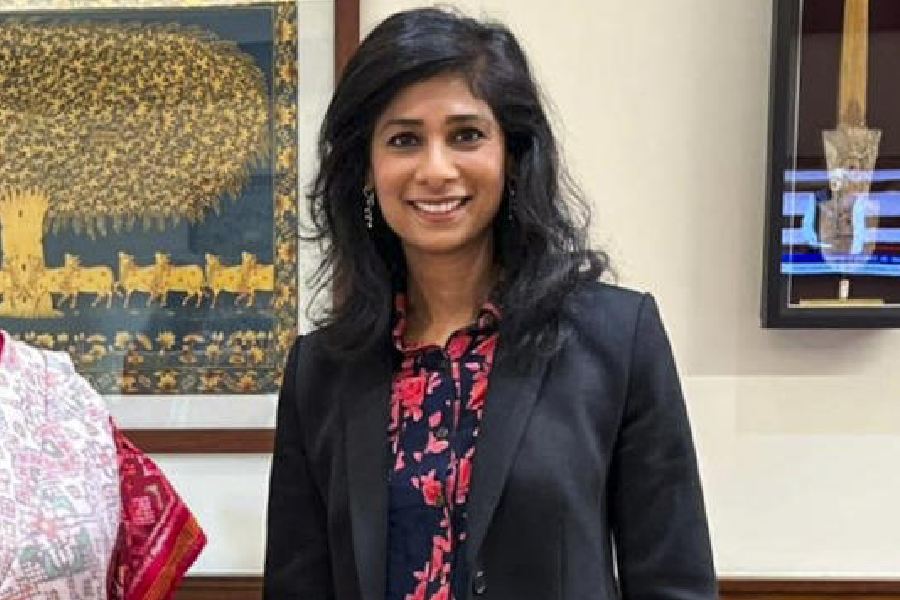-

BIRTH PANGS: Telugu Desam Party activists protest the creation of Telangana state, in Vizag
First came the official ruling on the divorce. Now comes the furious scramble to bag as many assets as possible.
The divorce in question? That between Telangana and the rest of Andhra Pradesh. Earlier this month, the Union Cabinet approved a decision to bifurcate Andhra Pradesh into two states — Telangana and Seemandhra. There was the predictable rejoicing in some parts of the state. But in others, protests continue. The reason, of course, is the innumerable stumbling blocks to a division.
The biggest bone of contention is the capital Hyderabad. It has been decided that Hyderabad will be the joint capital of the two states for 10 years, after which Seemandhra will have its own capital. But the city is not something Seemandhra would like to give up — now or later.
Hyderabad is India's fifth largest centre for software exports. Last month, the Cabinet cleared a Rs 2.19 lakh crore IT investment region in Hyderabad, capable of generating 15 lakh jobs. It is not just IT, the city has made huge strides in manufacturing, services, pharmaceutical, transport and real estate. Hyderabad's revenues constitute 50 per cent of the entire state's commercial taxes. What's more, it has the highest per capita income of Rs 86,897 in Andhra Pradesh. In fact, according to the Justice Srikrishna Commission report, a sixth of Telangana's gross domestic product (GDP) comes from Hyderabad.
This is a bitter pill to swallow for Seemandhra. Hyderabad may belong to Telangana historically, but people born after the merger of Andhra (which was itself carved out of Madras Presidency) with Telangana in 1956 on linguistic lines, have known only Hyderabad as their capital.
Many have homes, investments and jobs in Hyderabad and are insecure about their future. Will they be asked to relocate to the Seemandhra region that currently has no city to match Hyderabad?
Points out C.M. Ramesh, Telugu Desam Party (TDP) MP in Rajya Sabha, 'The real problem is Hyderabad. Most of the 9 million people living here are from Seemandhra. The city — its educational institutions, hospitals, film industry and five-star hotels — has been developed by enterprising business tycoons who hail from Seemandhra. Hyderabad contributes the maximum to the Andhra Pradesh state budget and now they tell us it does not belong to us.'
Palem Srikanth Reddy, president, TDP's professional cell, agrees. 'The fight has come down to the people. Even today Hyderabad contributes 42 per cent of the state's revenues and this goes to fund subsidies and the upkeep of education facilities,' says Reddy, whose father is a former chief justice of the state, who had moved from Madras Presidency to Hyderabad when they were reluctantly merged.
The current generation seems to be paying for history's mistakes, argue those who originally hail from Seemandhra. 'It will be difficult for Seemandhra to replicate a city like Hyderabad,' admits V.J. Naidu, a retired university professor.
However, he is among those who are optimistic that Seemandhra will become economically viable. 'Hyderabad has a huge concentration of manufacturers, wholesalers and traders, and the bustling business districts of Ranga Reddy and Nalgonda. Telangana might benefit at first but Seemandhara can develop once these trade and manufacturing companies move to that region,' he says. They also have the advantage of a big coastline and natural gas resources, he adds.
However, Seemandhra will also inherit a huge debt in the division on the basis of its larger population share. All assets and debts will be divided in the ratio of 60:40, the ratio of the population in each region.
Points out Hanumantha Rao, chancellor, University of Hyderabad, 'A number of head offices from Hyderabad will eventually shift to Seemandhara and people will start paying taxes there.'
Leaving aside the tussle over Hyderabad, will the city work smoothly as a joint capital for the next 10 years? Take the case of Chandigarh, which is the joint capital of Punjab and Haryana. Mohinder Singh, member, National Commission for Minority Educational Institutions, Chandigarh, calls the city a white elephant. 'Chandigarh could not develop as an IT park; nor could it open an international airport. Everybody's father is no one's father,' Singh says.
Adds Pramod Kumar, director of the Institute of Development and Communications, Chandigarh, 'A shared capital doesn't work too well, as is evident in Chandigarh. Because it's a Union Territory, the state loses out on investment. Punjab missed out on the IT revolution since it didn't have its own capital. No state benefits from the excise duty or VAT collection of Chandigarh. Haryana wasn't so much at a disadvantage, thanks to the development of Gurgaon and Faridabad. But Punjab got a raw deal.'
The other contentious issue between Telangana and Seemandhra will be the sharing of the Krishna waters. Krishna river, which flows into the Srisailam dam in Telangana and downstream to Nagarjuna Sagar, is used to irrigate the agriculturally dependent Andhra belt, including the drought-ridden Rayalaseema region. When the division happens, Telangana will have the upper hand because 80km of the river upstream flows through this region.
'Telangana could construct barrages and small dams in this stretch. Maharashtra has, in fact, done the same thing on the upper Godavari river near the Andhra Pradesh border, preventing water from reaching the Sriram Sagar dam in Telangana. Seemandhra, which is used to this water to irrigate their second crop, fears this,' says a senior official at the state irrigation and CAD department.
Moreover, the left bank of Srisailam dam falls in Mahbubnagar in Telangana, while the right bank lies in Kurnool district in Rayalaseema. Which side will control the important Pothireddy Padu head regulator of Srisailam dam which diverts the surplus Krishna waters to areas like Rayalaseema?
But even Telangana may not be completely without water problems. It is already building a number of lift irrigation projects to draw water from the Godavari and Krishna rivers. However, these projects are expensive to construct and will entail huge power bills, which is unsustainable for a relatively small state.
When it comes to power, it will be Telangana's turn to be on the backfoot. According to senior officials in APTransco, the government-run power transmission corporation, Telangana will face a shortage of 2,000MW. Most power generating stations are located in Seemandhra.
However, Mohammad Anwaruddin, director, grid transmission and management, APTransco, demurs. 'Telangana will get power from the national grid for southern states. Besides, power can be purchased from Maharashtra through an existing 765KW line,' he says.
An inter-regional grid installed with energy meters where the two lines cross each other is another alternative, he says. 'Today, states are also entering into private power purchase agreements to buy power from private stations,' he says.
Another volcanic issue is government jobs in the Telangana region. Andhra Pradesh has a complicated government job reservation system based on the number of years people have lived in a zone (the state is divided into six zones). The Telangana Rashtra Samithi, which spearheaded the movement for Telangana, has alleged violations in these reservations by 'Andhras'. According to Kodandaram, chairman of the Telangana Joint Action Committee, and a political science professor from Osmania University, 18 violations were identified by a committee set up to look into the matter. 'There have been violations through upgradation and conversion of open posts to reserved posts to suit Andhraites. We want this addressed.'
Kavitha Chandrasekhar Rao, daughter of TRS supremo K.S. Chandrasekhar Rao, too says that nearly one lakh Andhra natives who allegedly got government jobs this way would have to return to their own state — Seemandhra.
Government employees are not sitting quiet either. Nearly five lakh non-gazetted officers of the state have already started an agitation against the divide. They have also formed joint action committees all across the state.
Their agitation is for a united Andhra or Samaiyakandhra.
Bhadrachalam too could be a bone of contention. Located 300-odd km away from Hyderabad, this pilgrimage town in Khamman district will come to Telangana in the merger. It is also the site of Pollavaram, a mega national river dam project that can benefit the Krishna basin in Andhra. Predictably, both sides are laying stake to Bhadrachalam. Says Kavitha Rao, 'This area in Khamman belongs to Telangana.'
She also says that Telangana is not willing to part with Krishna waters for projects like PothiReddy, which releases water to Rayalaseema. 'We are already providing infrastructure to run their capital here for 10 years. Running a capital elsewhere is like having a kitchen in the neighbour's house,' she says, rubbishing the idea of sharing revenues with Seemandhra.
With so many sticky points in the way of a smooth division, how exactly will Telangana and Seemandhra come into being and thrive? A member of the Justice Srikrishna Commission which studied the demand for Telangana as an independent state, asserts, 'Neither Telangana nor Andhra can be viable on its own. Hyderabad may be the only income generating city in Telangana, but most of the investments have been made by people from Seemandhra. If Seemandhra people take them away, they will be lost. This concept of smaller states is not economically viable at all.'
Over to the UPA government in New Delhi.
The hurdles ahead
Krishna waters: The Andhra belt, including the drought-ridden Rayalaseema, depends on agriculture. But 80km of the Krishna upstream flows in Telangana. Telangana can construct barrages and small dams in this stretch.
Power: Power stations are largely located in the Andhra region.
Hyderabad: An industrialised city with job opportunities and an international airport (Tirupati does have an international airport but it's rudimentary), Hyderabad is the state's maximum revenue earner. Both states want the city.
Boundary line: Both states are claiming a portion of Khamman district where the national river water project Pollavaram is coming up.
Telangana negatives
No port.
To have a power shortage of 2,000mw.
The Telangana plateau needs lift irrigation plants to draw water. These are expensive and with a power shortage, there might be water shortages too.
Seemandhra negatives
Lack of water resources.
No Hyderabad — with its opportunities for jobs, higher education and so on.
People with homes in Hyderabad fear they may be forced to go back to the Andhra region.











